A First Impression of the One Eleven and Smithi Pro - The Day of the Long Lines
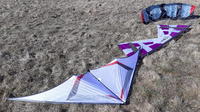
This session I planned to:
Test the new Level One, One Eleven.
Practice QLK (B-series mid vent) with long (40m) lines.
Test the new Smithi Pro kite.
Thu Mar 29 11:00:00 CEST 2018
GF, forecasted 3-4m/s, but was a bit varying
Level One, One Eleven on 35m 75kg lines
B-series 1.5 on 40m 40kg lines
Spiderkites, Smithi Pro also on 40m 40kg lines
Disclaimer: Do not consider this to be two proper reviews - it is just a first impression of the One Eleven and the Smithi Pro during a three kite session.
The One Eleven
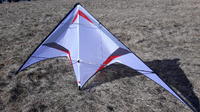
One Eleven, a 2.6m span width kite with a weight per area being very close to that of the HQ Shadow.
Though rarely using as long lines as 35m, I felt that this line length suited this large kite of 2.6m (8.53ft) well. I'd say that this kite extends the flight properties of my kite collection. There the closest thing would be the Tramontana. A very subjective description of the feeling when piloting the One Eleven (that unfortunately sounds piecewise negative): A very precise (and very light) barn door that moves on rails with close to zero radius turns. Very close and long powered ground passes could be performed, because I felt so much in control.
It tricks, but perhaps needless to say, tricking is performed with large hand movements, but without feeling ridiculously large. Another thing is the sound level, if my Hydra and Kymera sometimes gently hums for me, the One Eleven is more like a construction site angle grinder or a starting truck. Though to be fair I must say that I never attempted to tighten the leech line. The effect is striking when the sound stops or starts e.g. when doing a "snap" stall, initiating/ending a side slide, landing/starting, etc... I put the quote marks around "snap" because it is not so snappy - you can't aggressively tear this light kite it out of flight. Instead you need to be careful to extend the arms or move forward when doing the snapstall.
Spiral wound carbon fibre tubes - who needs them? This large kite use only two one piece loong 5.5mm tubes in the LEs - No possibility to disassemble the LE to make a half length LE package. Even the LS is loong, it is a one piece tube that you fold along the spine for transport. The kite doesn't fit into any of my (two) kite bags. You can't really be tough on the kite when when doing ground work. Nope no tubes broke, but one side of the (single piece) LS popped out of the equally slim fitting. Perhaps this will be as input taming for groundwork as my 4D was for general flight input? I kind of like this approach with the slim fittings on this kite though.
In a way, and this may sound strange, this kite makes me think of the Prism 4D. It is not only the colours that match, but also the narrow spar diameter (5.5mm tubes) in relation to the size of the kite. So let's see how close in a weight to area sense the One Eleven is to a couple of other kites. The areas used below are projected areas extracted from photos of assembled kites (by the number of the pixels of the kite), while the weight is from on-line kite data, mostly from the manufacturers sites.
4D (1.47m): 70.9g / 0.355m2 = 200g/m2
Shadow (2.07m): 195g / 0.603m2 = 323g/m2
One Eleven (2.6m): 280g / 0.833m2 = 336g/m2
Infinity (2.46m): 362g / 0.732m2 = 495g/m2
Nope, from these numbers the One Eleven seems to be more like a large Shadow than a 4D.
Another 4D comparison is the IMO unnecessary end caps on the stand offs that just falls off and gets stuck in the unnecessary large stand off fittings sitting on the LS. A small glue dot on the 4D stand off side that goes into the LS stand off fitting should reduce any possible risk of carbon fibres fraying/splitting? One Eleven starts in the configuration that my 4D happened to end in - there are no small end caps on the stand off here by design (and the LS stand off fittings are small instead).
I was a bit worried when unboxing the kite since the TS seemed to be too short - there were creases along the LE. I contacted Level One to get the correct line length. They responded promptly. If anything, it was actually a slightly longer than the nominal length. My worries seemed to be exaggerated. In the wind already on the ground the creases were largely gone. In the air the sail was like a smooth glittering silk/milk bubble!
For this large and light kite one compromise/sacrifice has been the required length of the kite (tyvek) sleeve. There are no mid LE fittings so that the leading edges can't be disassembled - this comes with the bonus of no extra weight for them. This is fine with me. I kind of appreciate when getting something different - a clear personality of the kite. Perhaps I'll add external straps to hold the sleeve on one of the kite bags. The only out-of-the-box working "kite" bag for this long kite is the ski bag. On the plus side is that the One Eleven sleeve is quite narrow.
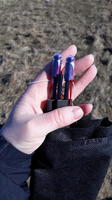
Wing tips and tyvek bag of the One Eleven.
The mid vent
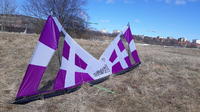
I couldn't get hold of a lime/yellow B-series mid vent that would have matched the B-series full sail and full vent sails better, since the type became rare and discontinued. The ski tracks behind the mid vent are a bit surprising. These tracks have survived this late in the year (mid Mars), though there is little shade there - they must have put on much snow on these tracks.
I can't remember if I have used the 40m line set before (initially I wasn't even sure I had one). However the lines had all been adjusted to the same length. Then I saw that two lines were covering the other two lines (perhaps I had used it for dual DLKs last summer?). They can't have been much used though, because when winding the line up I got the Climax yellow left index finger tip that is characteristic of a new line.
For the varying wind of the day I chose to use the B-series 1.5 mid vent. The two feather tubes were often too flexible for the wind, so I switched to three feathers. The motto for the day was: you don't need to do something fancy to improve. Just break your habits, make a turn&wump sequence that you don't usually do and make it shine. Stomp the bugs out of your flying one after one. Don't be lazy - don't do the inverted hoover when the wind drops, though the inverted hover would be easier to hold.

Though the ground appeared dry and warm, the kite stake screw driver couldn't easily be put into the ground today, because a few cm below the surface, the ground was still frozen - using this phillips screwdriver as a drill to get through the semi-frozen ground was the way to go. In the image another way of handling the frozen ground from a two week earlier session is displayed - Just put the stake through the hard snow/ice hybrid.
The Smithi Pro
So finally it was time to test the kite that I have had in mind for so long time. Except for some youtube videos and some general data about the kite, I didn't really know what to expect.
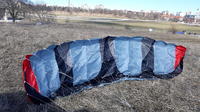
The Smithi Pro - the foil that can go backwards and hover but then requires quite active input.
To this point I've only tried two other foils: my 5m2 Peter Lynn Peel foil ( https://web.archive.org/web/20010303105904/http://www.kmd-sportdrakar.com:80/Peel4linor.html ) a couple of times (about five I'd say) in the end of the nineties and a budget not so very well working two line foil. I wasn't very thrilled by the Peel flight properties. Compared to my HQ Jam Session and HQ Maerstrale (which were the kites I flew at this time) it felt like a slow sleeping mattress with two brakes in the TE (OK I'm terribly unfair here, after all this Peter Lynn foil was a power kite, not a trick kite and my (foil) time at the lines was much limited). Nonetheless, I used it for it intended purpose (traction) at least two times. I did one (two?) practice sessions on skies on the Gärdet (full name: Ladugårdsgärdet) field in Stockholm. I then tended to end downwind to my initial starting point, but "cheated" and took the bus (line 69 - a bus line with a quite large share of tourists) back home again. With this much limited experience I went on a weekend chartered bus trip to Sälen (in the Swedish mountain range fjällen). There I proceeded beyond the end of the ski lift towards the top to try the traction foil out again. The wind was OK and the forward speed was low/moderate, which was good because of the many very low trees (spruce or birch tree - I can't remember - this was 1999 after all). After a while I got unexpected company, the snow mobile ridden rescue team showed up and asked if everything was OK (which it was). Perhaps they had mistaken the traction foil for a crashing paraglider?? I'd say that this top tour was the end(?) and height of any traction adventures. Non the less this kite might still be the most important one of them all - It was during this weekend that I saw my wife for the first time. Ohh, did I just get slightly off today's topic?
So how was the Smithi Pro compared to the framed (Rev) quads? Nope, it is not the same thing - it is, big surprise, a (quad) foil. Maintaining hovers demands more active input (like DLK slides???), the kite (in my rookie foil hands) tended to choose either to fly forwards or backwards. Yes backward flight is possible, to my understanding a kind of hallmark of the Smithi Pro. The air ram intakes are so that the backwards flight is possible. However anything but the slowest of side slides would fold a wing tip. The trickiest one was to fly side slide upwards - this always folded it. The above sounds too negative since I judge this foil seen through the glasses of framed Revkites. The above being said, it is a very maneuverable kite on its own:
In the sales text it said that the Smithi Pro wouldn't pull so hard and that one should use light lines to enhance the low wind performance of the kite. According to Christoph Fokken (the designer), the Smithi Pro got better low wind performance than the larger Smithi due to the materials used in the kite. Well today wasn't the day to calmly explore the low wind properties.
When I got the recommendation to go for the smaller Smithi Pro due to the low wind capabilities of the kite to better fit the low wind in my area, I felt a sting of disappointment fearing that I hardly would feel the pull. There was no need to worry - I got a pleasant and forceful pull without any worries that I'd snap any frames or change delicate properties by permanently stretching the sail or just having a general feeling that I just shouldn't. I did not want any more pull though, since I only got 40kg lines out today. Now I need to wait for the regular power kiters to show up here on some future session, so that I can do some kite control showing off ![]() (I hope).
(I hope).
There is one test I'd like to do with this kite and that is to add (tape) something flexible to the wing tips to postpone the collapse when attempting side sliding. For this test I'd use the plastic foil construction tape since it leaves no residues. Whatever flexible beam used of whatever width, should be flexible enough not to crack and while possibly even so soft that it can follow the shape of the foil. Another approach could be to add a 1.5mm (?) carbon rod along the LE and the wing tip?


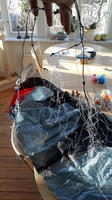

0 Comments
Recommended Comments
There are no comments to display.